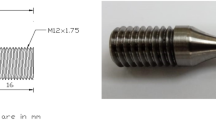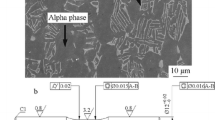Abstract
Titanium alloys are considered as an attractive material for aerospace applications owing to their unique characteristics such as high specific strength, good ductility, and better corrosion resistance. IMI 834 alloy is a near α Ti alloy that is used in the compressor discs and blades of turbine engines. These components rotate at very high rotational speed and often experience the combined effect of axial and centrifugal stress. It has been noticed that the failure of these components occurs due to the cyclic load during its normal operation. Hence, the aim of the present study is to evaluate the tensile and multiaxial fatigue behavior of IMI 834 alloy at room temperature. Tensile tests are performed at a strain rate of 6.67 × 10–4 s−1. Fully reversed pure axial, pure torsion, and combined axial-torsion fatigue experiments are conducted on the tubular specimen in in-phase load conditions at a frequency of 0.3 Hz. Hysteresis loops are determined for all the fatigue tests at half of the fatigue life. Cyclic stress response curves are generated and noted that the alloy tends to show neither cyclic hardening nor cyclic softening during the pure axial fatigue. On the other hand, it shows cyclic softening for the case of pure torsion and combined axial-torsion fatigue. Subsequently, the fatigue life is correlated to Von-Mises equivalent stress and strain under various load combinations. The alloy exhibits the lowest fatigue life under combined axial-torsion load and the highest life under pure torsion fatigue. It is noteworthy to observe that the effect of axial fatigue is more dominant under the combined axial-torsion fatigue. Pure torsion fatigue specimens are noted to fracture at 45° whereas pure axial fatigue specimens fracture at 90° to the specimen axis.
Access this chapter
Tax calculation will be finalised at checkout
Purchases are for personal use only
Similar content being viewed by others
References
Boyer RR (1996) An overview on the use of titanium in the aerospace industry 213:103–114
Lutjering G, Williams JC (2007) Titanium, 2nd edn. Springer, New York
Kolli RP, Devaraj A (2018) A Review of Metastable Beta Titanium Alloys. Metals (Basel). 8:1–41. https://doi.org/10.3390/met8070506
Eylon D, Fujishiro S, Froes FH (1984) Titanium Alloys for High Temperature Applications—A Review. High Temp Mater Process 6:81–91. https://doi.org/10.1515/HTMP.1984.6.1-2.81
Singh N, Singh GV (2006) Low cycle fatigue Behaviour of Ti alloy Timetal 834 at 873 K. Int J.Fatigue 29
Singh A, Balasundar I, Gautam JP, Raghu T (2019) Effect of primary α phase fraction on tensile behavior of IMI 834 alloy. Procedia Struct. Integr. 14:78–88. https://doi.org/10.1016/j.prostr.2019.05.011
Prasad K, Sarkar R, Ghosal P, Varma VK (2008) The influence of dynamic strain aging on the low cycle fatigue behavior of near alpha titanium alloy IMI 834. Mater Sci Eng A 494:227–231. https://doi.org/10.1016/j.msea.2008.04.025
Bache MR, Evans WJ (1992) Tension and torsion fatigue testing of a near-alpha titanium alloy 5:331–337
Joseph J, Bonnen F (1998) Multiaxial fatigue response of normalized 1045 steel subjected to periodic overloads: experiments and analysis I * m
Wu Z, Hu X-T, Song YD (2014) Multiaxial fatigue life prediction for titanium alloy TC4 under proportional and non-proprtional loading. Int J Fatigue 59:170–175
Renzo DA, Sgambitterra E, Magarò P, Maletta C, Biffi CA (2020) Multiaxial fatigue behavior of additively manufactured Ti6Al4V alloy: axial—torsional proportional loads. 1–10. https://doi.org/10.1002/mdp2.190
ASTM E8 (2010) ASTM E8/E8M standard test methods for tension testing of metallic materials 1, Annu B ASTM Stand 4(02):1–27. https://doi.org/10.1520/E0008
Standard Practice for Strain-Controlled Axial-Torsional Fatigue Testing with Thin-Walled Tubular Specimens, Annual Book (2008) 1–8. doi:https://doi.org/10.1520/E2207-08.2.
Gao Y, Wang G, Liu B (2016) Chip formation characteristics in the machining of titanium alloys: a review. Int J Mach Mach Mater 18:155–184. https://doi.org/10.1504/IJMMM.2016.075467
Wagn RF, Li YT, An HP (2013) Low cycle fatigue life prediction of Ti-6Al-4V titanium alloy under multi-axial non proportional cyclic loading. 668:814–817. https://doi.org/10.4028/www.scientific.net/AMR.668.814
Wu J, Lin C (2005) Effect of strain rate on high-temperature low-cycle fatigue of 17–4 PH stainless steels. 390:291–298. https://doi.org/10.1016/j.msea.2004.08.063
Zhang S, Zhang H, Hao J, Liu J, Sun J, Chen L (2020) Cyclic stress response behavior of near β titanium alloy and deformation mechanism associated with precipitataed phase. Metals 10:1482
Evans WJ, Whittaker MT, Jones JP (2007) Torsion fatigue in near alpha and alpha-beta titanium alloys. Japan Inst Met 1333–1336
Rao KS, Prasad K, Varma VK, Singh V (2008) Influence of hold time on low cycle fatigue behaviour of near alpha titanium alloy IMI 834 At 873K. Trans Indian Inst Met 61:407–414
Acknowledgments
The authors would like to thank Defence Metallurgical Research Laboratory (DMRL), Hyderabad for providing the material and multiaxial fatigue test facilities. We are also thankful to Mr. Nagendra Babu, Mechanical Behavior Group, DMRL, and Mr. Chandan Sharma, Electron Microscopy Group, DMRL for hel** in the fatigue specimen preparation and microstructural characterization.
Author information
Authors and Affiliations
Editor information
Editors and Affiliations
Rights and permissions
Copyright information
© 2022 The Author(s), under exclusive license to Springer Nature Singapore Pte Ltd.
About this paper
Cite this paper
Arohi, A.C., Kumar, V., Babu, N.C., Narasaiah, N. (2022). Multiaxial Fatigue Behavior of Near Alpha Titanium Alloy for Aeroengine Applications. In: Jonnalagadda, K., Alankar, A., Balila, N.J., Bhandakkar, T. (eds) Advances in Structural Integrity. Lecture Notes in Mechanical Engineering. Springer, Singapore. https://doi.org/10.1007/978-981-16-8724-2_17
Download citation
DOI: https://doi.org/10.1007/978-981-16-8724-2_17
Published:
Publisher Name: Springer, Singapore
Print ISBN: 978-981-16-8723-5
Online ISBN: 978-981-16-8724-2
eBook Packages: EngineeringEngineering (R0)




